REMEMBERING TUSHAR KANTI-PAUL
1936 to 1 July 2020
This is the story of the first Bahá’í youth to have accepted the Faith in Malaysia and one who also became the first home-front pioneer as well. This story brings to the fore some of the salient services rendered by this exemplary youth in the early days of the development of the Faith in this country.
The circumstances leading to the acceptance of the Faith by Tushar have been dramatic. While Dr. K. M. Fozdar and his wife Shirin Fozdar from India were pioneering in Singapore in the early 1950s, they engaged in writing articles and placing advertisements on the Faith in the local newspapers to reach a wider circle, with hope of attracting waiting souls. In early 1954, one such advertisement in the Straits Times daily caught the attention of three brothers from the Bengali community in Malacca: Mirinal Kanti Paul, Pijush Kanti Paul and Tushar Kanti-Paul. Mirinal was the eldest and was a good writer, often contributing articles to local magazines. The other two were students taking the Cambridge School Certificate Examinations. The advertisement in the Straits Times read “Information on Bahá’í World Faith – write to Shirin Fozdar P. O. Box 1779, Singapore.” On reading this advertisement, the Paul brothers wrote to Shirin Fozdar and within a few days were delighted to receive a loving reply along with two yellow-coloured pamphlets on the Bahá’í Faith. As religious matters were sensitive within their family, these brothers decided to hide the pamphlets from their Hindu parents, with the thought of showing it to them when the opportune moment came by. However, they continued communicating with Shirin Fozdar with great enthusiasm to get to the root of these inspiring glad tidings.
Meanwhile, as a follow-up with their communications with Shirin Fozdar, the Paul brothers arranged for a big tea party at their home at 2886C, Tan Teck Chye Avenue, Klebang Kechil, Malacca, to enable Shirin Fozdar to introduce the Faith. Mr. Saurajen Ganesan, the first believer of Malacca town brought Shirin Fozdar to speak at this fireside. That was the first Bahá’í fireside in Malacca. A total of 35 friends came for the tea party cum fireside. Madam Hiran Prova Paul (nee Rai), the mother of the Paul brothers, prepared cakes and other refreshments, not aware of exactly what the event was. Mr. Jamini Kanti Paul, the father of the Paul brothers, was upstairs when the fireside was going on in the spacious ground floor. Tushar says that his father was listening to Shirin’s talks from upstairs. In her talk, Shirin quoted a passage from the Hindu scripture of Baghavad Gita, in Sanskrit, which Jamini Kanti Paul heard from upstairs where he was seated. On a later day, Jamini Kanti Paul commented to his sons that he had high respects for Shirin who was well-grounded in Hinduism as well as the Bahá’í Faith.
Even before the fireside took place, the Paul brothers were already convinced about the truth of the mission of Bahá’u’lláh through the communications and literature received from Shirin Fozdar. But at this fireside all doubts vanished from their hearts. After the tea party the Paul brothers accepted the Faith of Bahá’u’lláh by signing Bahá’í declaration cards on 15 March 1955. Mirinal and Pijush were adults and so they signed the declaration cards for adults, while Tushar signed in a special card for youth. Thus, Tushar was the first to sign his name on a youth declaration card in Malaya. Tushar Kanti-Paul, by his own account was only 14 years and 7 months when he accepted the Faith, although there are claims by others that he accepted the Cause when he was 17 years old.
Shirin was naturally happy that a wonderful beginning was taking place in Malacca. To Tushar, Shirin Fozdar said, “Tushar, you are the first Bahá’í youth of this country.” Then turning to all the three brothers she said, “Now you are my true sons.” That day, Shirin Fozdar became Mummy for the three brothers, and that was the beginning of Shirin Fozdar turning “Mummy” for all the Malaysian Bahá’ís as well, and she henceforth was referred to as the Spiritual Mother of the Bahá’ís of Malaya. She also became the “Spiritual Mother” of the Bahá’ís of South East Asia.
As the Faith was growing fast in Malacca the Bahá’ís needed a meeting place to have regular activities. In 1955, the parents of the Paul brothers went back to India for a period of five months and their house soon became a hive of activities for the Faith. It was in this house that the first Local Spiritual Assembly was elected on 21 April 1955. Tushar and Pijush cooked and played some popular Hindi songs on their gramophone player. Dr. K. M. Fozdar was in a happy mood on account of the formation of the first Local Spiritual Assembly in Malacca and started to sing a few old Hindi songs. Yankee Leong from Seremban was also there, and he spoke some words of encouragement, after which the Local Spiritual Assembly was elected.
Meanwhile the Fozdars then turned their attention to the parents of the Paul brothers who were already familiar with the Faith. In their subsequent visits, they took the parents for dinner and spoke about the Faith over dinner. Jamini Kanti Paul, the father, decided to give full freedom to his children but he himself did not become a Bahá’í and remained a devout Hindu. While he loved the Bahá’í Faith, he feared retribution from the small but close-knit Bengali community in Malacca. He passed away in 1967 in Malacca and had a traditional Hindu funeral and cremation. Their mother, Hiran Prova Paul, coming from an orthodox Bengali background remained a Hindu at that time.

Jamini Kanti Paul and Hiran Prova Paul
From the day Tushar accepted the Cause, he was on fire with the love of Bahá’u’lláh and His glorious Cause. His rise in the Faith was meteoric and was constantly on the move involving in as many activities as possible and availing himself whenever there was a need. He picked up knowledge of the Faith very fast, and his first spiritual nourishment came from Dr. K. M Fozdar and his wife Shirin who made constant visits to Malacca town to deepen the new believers. After the passing of Dr. Fozdar in 1958. Mrs. Shirin Fozdar continued to deepen Tushar on her visits to Malacca. Tushar received further nourishment from the several visiting Bahá’ís from abroad, principally the Hands of the Cause of God who diffused divine fragrances through what they spoke at the early gatherings. Some of the Hands whom Tushar met and basked under their guidance in those early days on the Malaysian soil were Mr. Shu’á’u’lláh ‘Alá’í, Mr. Abu’l-Qásim Faizi, Miss Agnes Baldwin Alexander, Dr. Raḥmatu’lláh Muhájir, Amatu’l-Bahá Rúhíyyih Khánum, and Mr Harold Collis Featherstone.
Tushar holds a special place in the history of the Faith in this country, not only as the first youth to have accepted the Faith, but as the first to become a home-front pioneer as well. It was Tushar Kanti-Paul who opened Jasin to the Faith. Once the Local Spiritual Assembly was formed in Malacca town during Ridván 1955, Dr. and Mrs. Shirin Fozdar requested Tushar who was about to start his job as a teacher to consider the possibility of moving to Jasin district as a pioneer. In 1955, Jasin was declared a ‘black area’ owing to communist insurgency in that town. The communist movement in Malaya was declared illegal. People generally feared going into areas dominated by communist insurgents. But here was Tushar who loved the Faith more than fearing his own life. The Faith had to be served. He approached the Education Department in Malacca and asked for a voluntary posting to Jasin and secured a transfer to work in Jasin English School in 1955. Thus, Tushar Kanti-Paul became the first home front pioneer in Malaya.
When in Jasin, Tushar was fully committed to teaching the Faith in every possible way. In 1957, Raymond Peter who was working as a Probationary Health Inspector in Jasin befriended Tushar. Peter had a motorcycle on which he would take Tushar Kanti-Paul for teaching trips in the rubber plantations. There, Raymond would translate talks by Tushar from English into simple Tamil. Whenever Tushar was tired, Raymond would then take over and talk about the Faith! When asked, Raymond was adamant that he was not a Bahá’í and that he was only helping Tushar in his teaching work. It was in March 1958 that Peter himself accepted the Faith. Leong Ho Chew from Malacca town was posted to Jasin while Anthony Louis too came to work in Jasin town. They all teamed up for activities. One of the regular activities of the Jasin Bahá’í community was to organise firesides. Leong Ho Chiew, Anthony Louis and Tushar Kanti-Paul organised these firesides in Leong Ho Chiew’s quarters and Saurajen and Leong Tat Chee would give talks. After participating in the first Bahá’í Summer School in December 1957, Miss Jeanne Frankel an American pioneer and her mother Margaret Kelly Bates also came to assist in the development of the Faith in Malacca. With all of them working together, the first Local Spiritual Assembly of Jasin was elected at Ridván 1958 with Tushar becoming its secretary.
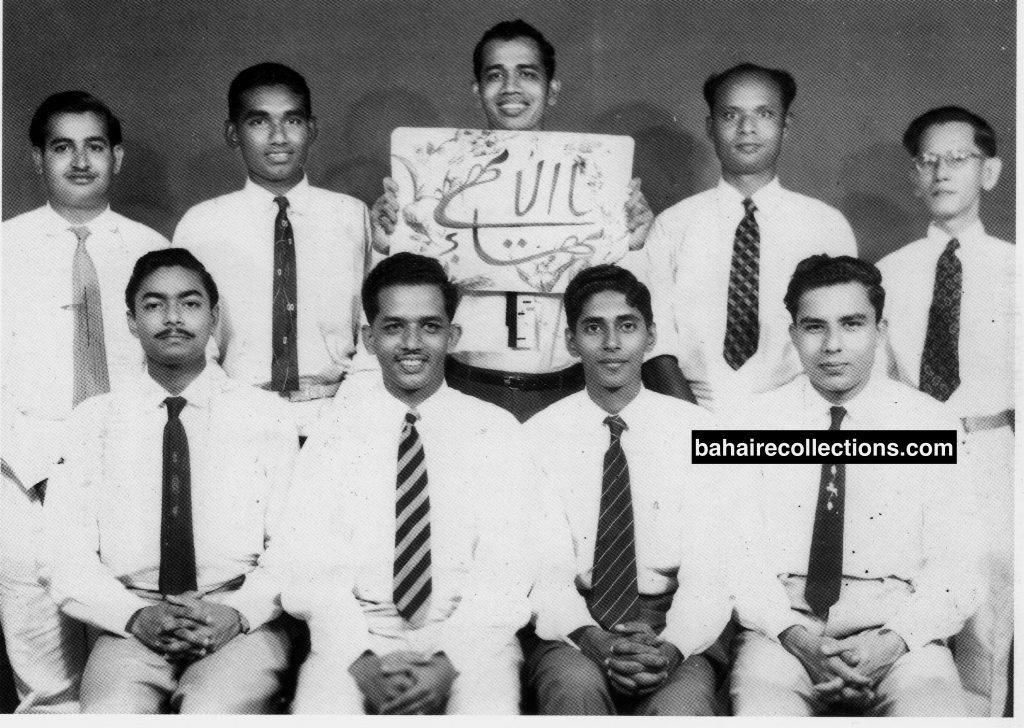
First Local Spiritual Assembly of Jasin, 1958. Seated (L-R) Tushar Kanti-Paul (Secretary) E.A. Fernandez (Chairman), Arthur Knight (Vice Chairman), Chakrabarthy (Treasurer). Back row (L-R) Surinder Singh, Raymond Peter, Anthony Louis, Arumugam Ramanan and Goh Tiow Li
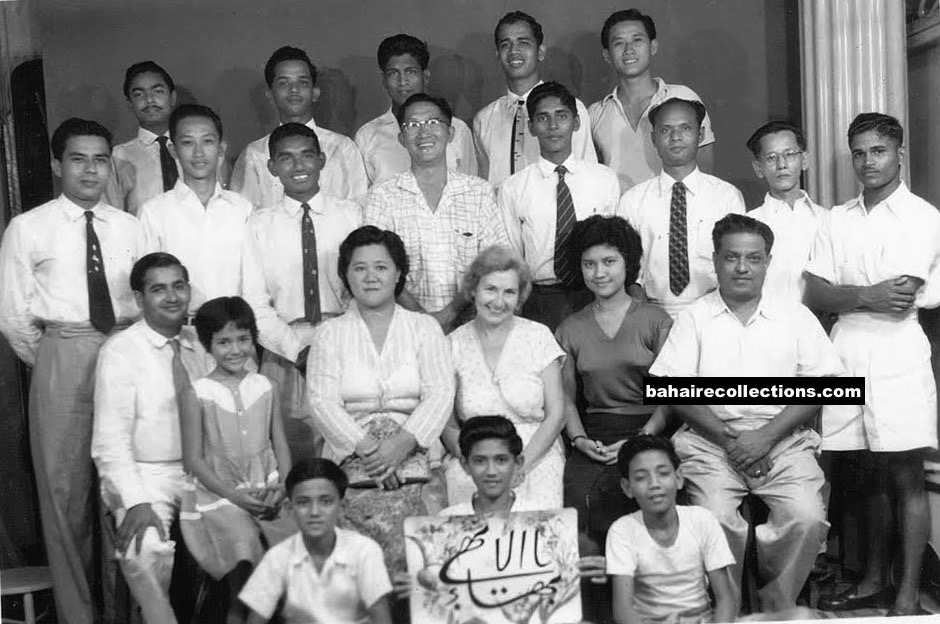
Some believers of Malacca state in a group photograph taken in a studio in Jasin, to celebrate the election of the first Local Spiritual Assembly of Jasin. Seated (L-R) Surinder Singh, Lena Saurajen, Margaret Kelly Bates, Elaine Saurajen, G. Saurajen. Standing in the middle row (L-R) Chakrabarthy, Leong Ho San, Raymond Peter, Leong Tat Chee, Arthur Knight, Arumugam Ramanan, Goh Tiow Lim, Jami Subramaniam. Back row (L-R) Tushar Kanti-Paul, E.A. Fernandez, Kumara Das, Anthony Louis and Leong Ho Chiew
Tushar was obsessed with engaging in estate teaching as the simple estate people were very receptive to the message of Bahá’u’lláh. Tushar went to several estates in Malacca state in the company of Tamil speaking believers including S. Vasudevan. He was also on teaching teams that were formed to teach in both urban and estate areas.
While stationed in Jasin, Tushar was actively involved in almost all activities in several parts of Malacca state. He was an active participant in the Teaching Conference held in Malacca in July 1957, was one of the earliest teaching conferences in the country. The Boy Scout Headquarters in Mata Kuching Road was one more popular spot where many activities took place in the early days in which Tushar participated. Tushar participated in the first Summer School held in December 1957 at the residence of Mr. G. Saurajen at 17, Fort Terrace. When Dr. Muhajir called for a special meeting with some 25 believers who turned up for the Summer School to discuss plans for the whole of Malaya, Tushar was one of them Dr. Muhajir selected. Tushar took up some responsibilities that were tasked to him. That was the first Summer School for Tushar and he made sure he participated in the early Summer Schools held in Malacca.
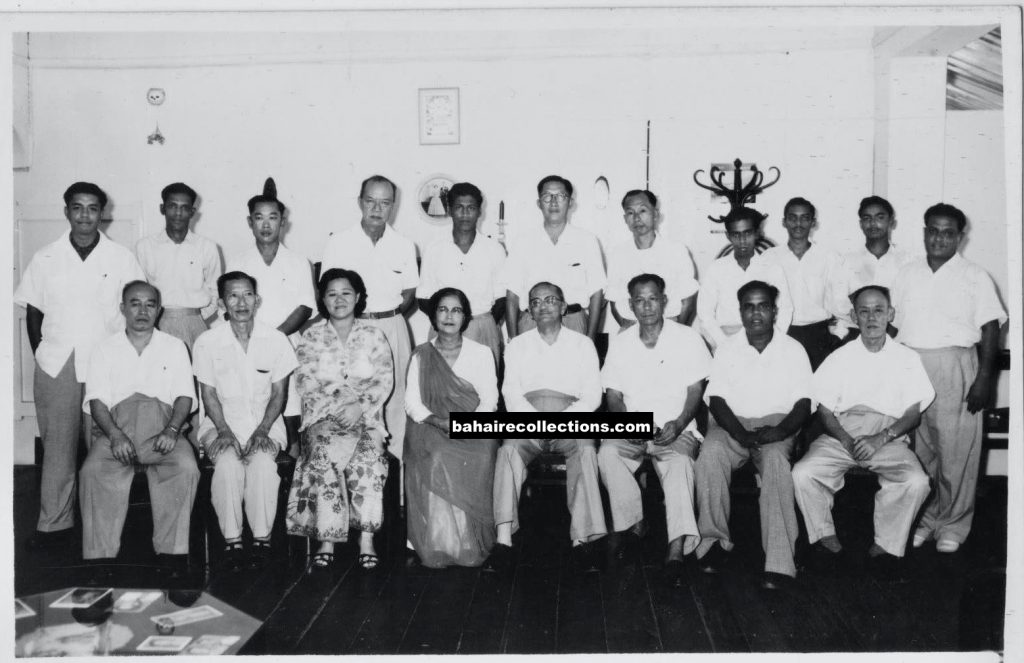
Teaching Conference of July 1957. Seated second from left is Yankee Leong, third from left is Lena Saurajen, fourth from left is Shirin Fozdar, fifth from left is Dr K.M. Fozdar. Standing at the extreme right is Saurajen, and to his right are Tushar Kanti-Paul, Pijush Kanti Paul and Mirinal Kanti Paul. Kumara Das stands fifth from left, with Leong Tat Chee sixth from the left
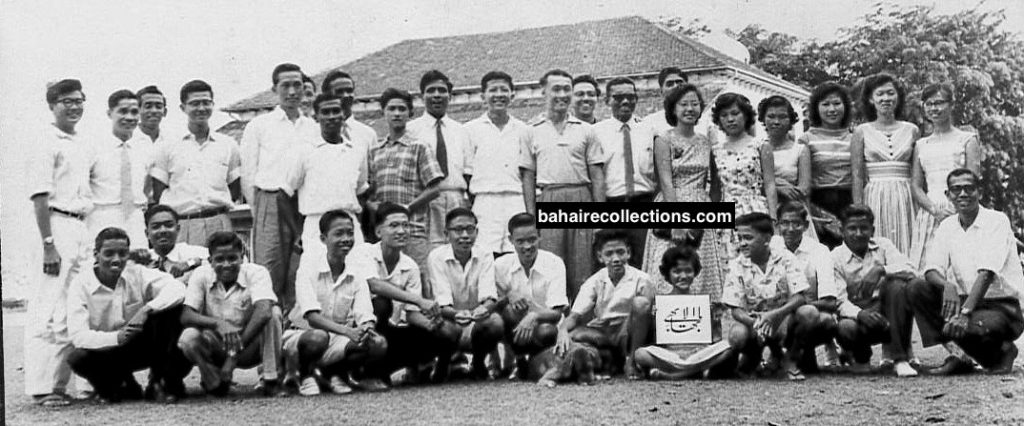
A gathering at the Boy Scout Headquarters, circa 1958. Kumara Das is in the middle with black necktie. Anthony Louis is squatting at the extreme right. Koh Ai Leen is standing at the extreme right. Lily is standing third from right, Raymond Peter stands eighth from right. Leong Ho San is standing fifth from the left, with M. Maniam standing in front of him. The three squatting from left are Pijush Kanti Paul, Tushar Kanti-Paul and Jami Subramaniam
In those days there were several teaching conferences organized in Malacca. Tushar participated in the First Pan- Malayan Teaching Conference held on 8 May 1960 at Happyland Hotel in Klebang Kechil, Malacca. The conference was graced by Hand of the Cause Dr. Muhajir. At that conference a Teaching Planning Committee was established, and Tushar Kanti-Paul was appointed onto that Committee.
Yet one more area of Tushar’s involvement was teaching the Cause to the Asli believers. After the conclusion of the Pan-Malayan Teaching Conference in the Happyland Hotel in Malacca on 8 May 1960 a team went to this Asli area, headed by Dr. Muhajir. Tushar was among those who followed Dr. Muhajir to this Asli area.
At the Summer School of 1960 held in Port Dickson Dr. Muhajir suggested the appointment of state representatives to open virgin areas in the country to the Faith. Tushar was one of those appointed to open Masjid Tanah area for the Faith.
Tushar had a painting talent which he used for the Faith. In 1961, Tushar received a government scholarship and underwent a Specialist Teachers’ Course in Arts and Crafts at the Teachers Training Institute at Cheras Road, Kuala Lumpur. Tushar completed his course and returned to Malacca in 1961 and became actively involved in Bahá’í activities. Tushar became the secretary of the Local Spiritual Assembly from 1962 to 1966 when he left for Australia for good. He was an able administrator who kept the records in order.
The early part of 1961 was the time when Malacca community faced some crisis and emerged victorious. There was a new zeal among the believers to take up the Faith to a higher pedestal. Tushar was fully committed to this task. In 1961 the Watch Committee was appointed by the Local Spiritual Assembly of Malacca Town. Some of the most active members were appointed on this Watch Committee and their task was to assist in the consolidation of the community, especially in gathering Bahá’ís who had not been attending Nineteen Day Feasts and fireside meetings for some time. Among those who were appointed on this committee were Pijush Kanti Paul as Chairman, S. Vasudevan as Vice Chairman, Tushar as Secretary and Jami Subramaniam, Nadarajan, Pravin, Nadarajah and Maniam as members. The committee worked hard and provided transport for those living far away and sent out attractive reminder cards about dates of meetings, firesides, feast days, Bahá’í Holy Days and other important events. The committee members also made visits to the homes of Bahá’ís who were not seen at Bahá’í functions for a considerable period of time. Soon the Malacca town community became very active registering good number in the attendance at feasts and other activities.
Tushar also has the distinction as one of those conducting Bahá’í wedding even as a bachelor. On 31 August 1961, Maheshwar Dayal a pioneer from India to Singapore and later to Malaya, married a local girl by the name of Teh Poh Yoke. That was the first Bahá’í wedding to be officially endorsed by the Local Spiritual Assembly of Kuala Lumpur. This was a simple wedding conducted by Tushar the Malacca Bahá’í youth, at the residence of Maheshwar Dayal in Petaling Jaya. Many Bahá’ís from Kuala Lumpur, Seremban and Malacca communities came to witness this wedding.
Tushar, who was a well-read believer, was also selected to be a speaker at various Bahá’í activities. When the Bahá’í youth of Seremban organized the first Pan-Malayan Youth Conference in the Negeri Sembilan Indian Association Hall in Seremban town from 16 to 18 December 1961 Tushar spoke on the topics of “Science and Religion” and “Words of Wisdom” and his talks were well received by the participants. Later, on 6 October 1963 the youths of Seremban organized a Regional Youth Conference where Tushar spoke on “Words of Inspiration and Encouragement.” In the English group there was a written test on the Bahá’í Administration and Tushar Kanti-Paul won a prize, which was not a surprise to many who had known of deep knowledge on the Faith.
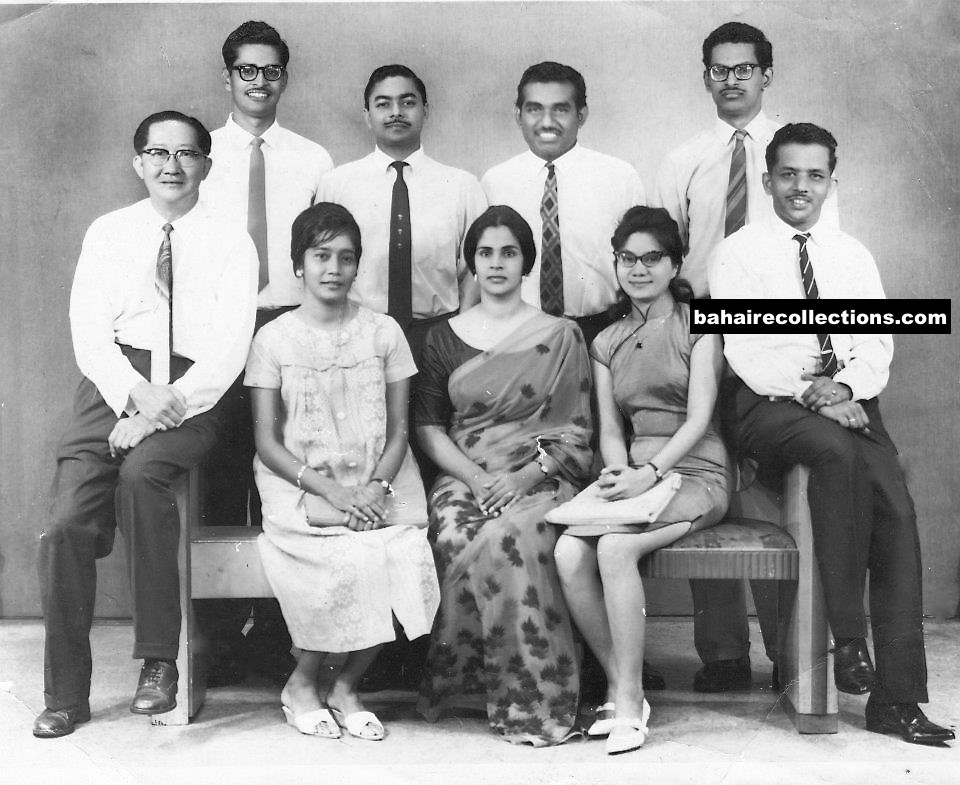
Local Spiritual Assembly of 1963. Seated (L-R) Daisy Das, Betty Fernandez, Chiang Kim Lin. At the extreme left is Leong Tat Chee, and at the extreme right is E.A. Fernandez. Standing (L-R) S. Vasudevan, Tushar Kanti-Paul, Raymond Peter and S. Bhaskaran
Meanwhile Tushar was one of those who attended the First Bahá’í World Congress was held at the Royal Albert Hall in London from 28 April to 2 May 1963. When the National Convention was held for the election of the first National Spiritual Assembly of Malaysia Tushar was elected as a delegate representing Malacca town community.
Producing literature for the Faith was one more area of activity for Tushar, at a time when there were not too many local literature published. In 1964, Tushar and S. Bhaskaran teamed up and produced a booklet called “Manual for Pioneers.” It contained extracts from the book “The Advent of Divine Justice”. Dr. Muhajir who was very pleased with that booklet requested them to send two copies to the Universal House of Justice, as he felt the Universal House of Justice should have a record of all publications.

Summer School held in August 1965 at the Malacca Youth Hostel. L-R: Tushar Kanti-Paul, Rustam and Nirmala
Tushar had a special role in the National Teaching Institute building that was erected in Bukit Baru, Malacca, which was the first of its kind in Malaysia and the whole of Southeast Asia. In 1964, the National Spiritual Assembly of Malaysia set up a Building Committee to develop that national teaching institute building Kumara Das and Tushar looked into the legal aspects. By July 1965, the Institute building was completed. When it was completed, Tushar an artist himself painted a mural on one side of the inner wall. To this the National Spiritual Assembly felt very proud and appreciated his generous gesture.
Tushar was also becoming popular in the outside world as painter of rare kind. Tushar had developed a unique way of painting. While painters used brushes to paint, Tushar used finger techniques. Tushar was an art teacher at the Gajah Behrang Secondary School in Malacca town. At school he was teaching painting using brush and watercolor. It was at these classes that Tushar used to glorify great painters like Picasso to the student. He inspired many students to take up painting as a hobby. He had such a strong passion for painting and the painters. But he did not teach finger painting at school. Finger painting technique was an art that he developed for his own passion. In the 1960s the Esso Oil company in Malaysia which had heard of his talent sought Tushar to contribute finger paintings to their magazine named PELITA, which he did and were well received.
Tushar’s fame and name were noised outside Malacca too. In 1965 the Arts Council of Malaysia sponsored an exhibition for the paintings by Tushar at the British Centre in Kuala Lumpur. It was attended by thousands of art admirers who watched Tushar’s finger painting technique.
His talents were noised abroad too. In 1966 Tushar went to Australia when sponsored to conduct an art exhibition and a keynote speaking tour. While he was on tour he met Miss Kathleen Hewson, daughter of early believers Thelma and Bill Hewson in Gawler, South Australia. He married Kathleen Hewson on 17 December 1966 at a much-publicized Bahá’í ceremony, which was held in the garden of the bride’s home in Willaston. Hand of the Cause of God Mr. Collis Featherstone conducted the wedding while Auxiliary Board member Howard Harwood was the Master of Ceremonies. Guests of many nationalities were present, and they came to know of the Faith when Mr. Featherstone gave a beautiful talk. And press publicity that followed the wedding exposed many others to the Faith. With this wedding Tushar had migrated to Australia.
The elder brothers of Tushar- Mirinal and Pijush had served the Cause effectively in their own ways before migrating abroad in 1964. Mirinal Kanti Paul migrated to take up a post as headmaster of Dryberg College in Singapore before migrating to London in 1964 to pursue his interests. Mirinal passed away in London in August 1988 Pijush Kanti Paul migrated to Toronto in Canada in 1964 as an artist and opened an art shop selling his paintings. He had organised a number of exhibitions in Toronto, and was always in touch with the believers and the Bahá’í community in Toronto.
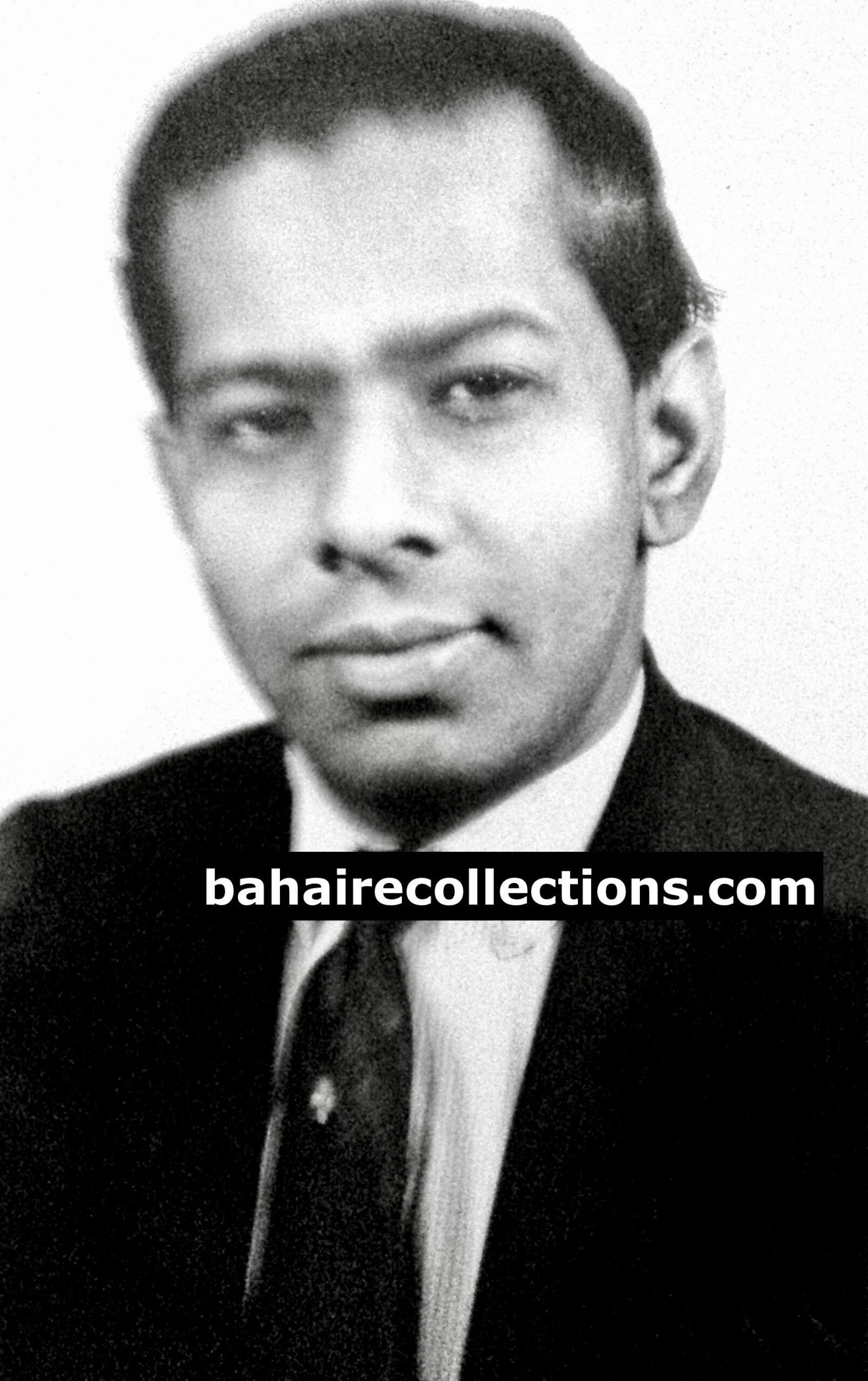
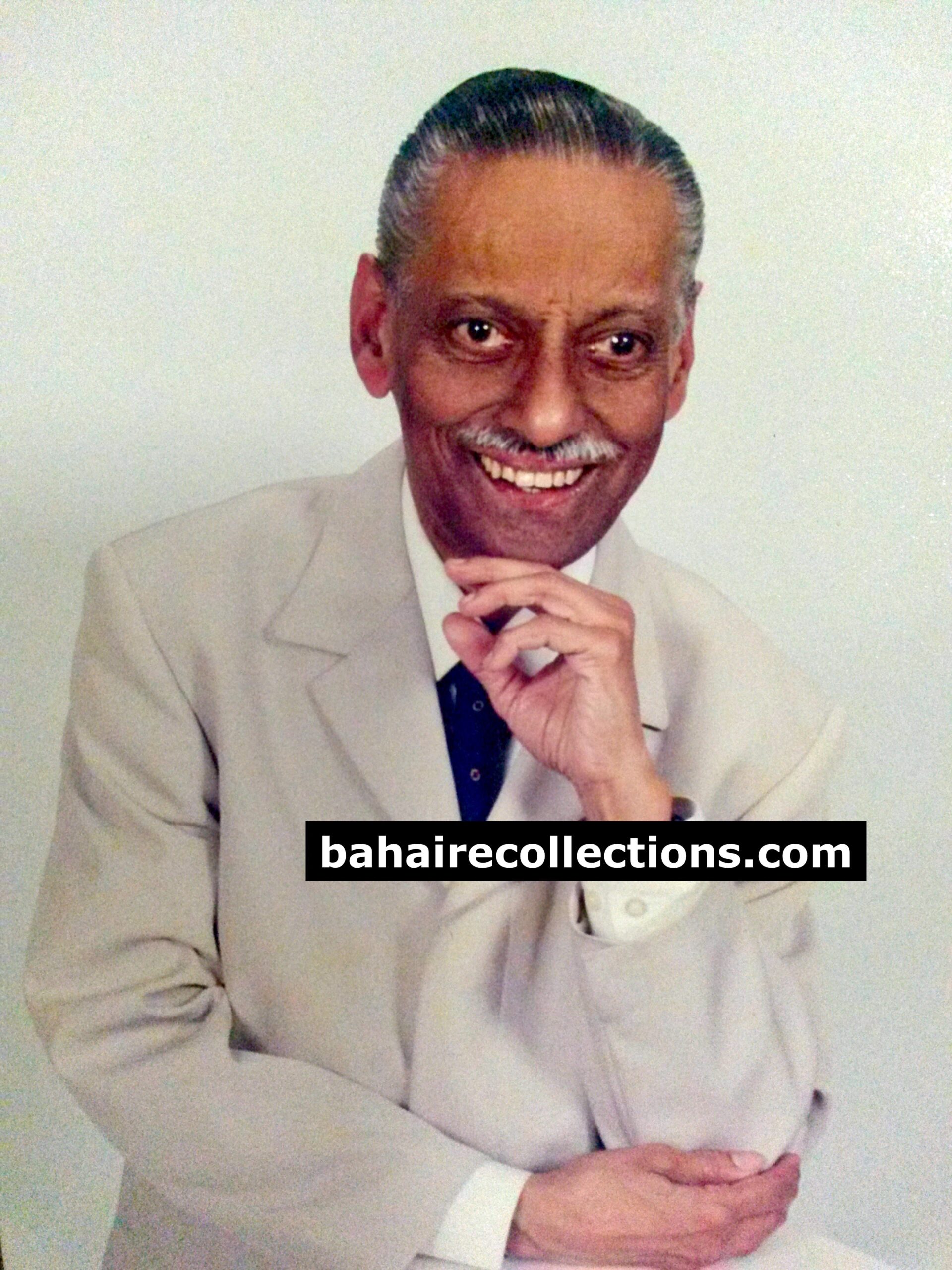
Mirinal Kanti Paul (L) and Pijush Kanti Paul (R)

A finger painting of Pijush bought by Lum Weng Chew of Toronto.
While in Australia, Tushar’s heart was still in Malaysia where he had discovered and grown in the Faith. Tushar came on a visit to Malaysia with his wife to attend the national convention held in the Third Residential College at University Malaya, Kuala Lumpur in 1967. When asked to speak at the convention, Tushar spoke on the many activities that took place in many parts of Australia in which he was involved, and registered great admiration for the way in which the Australian Bahá’ís coped with their problems and challenges. There were two other family members who came along. One was Tushar’s sister Mamata Paul, an active secretary of the Youth Committee in Malacca. The one other family member who came for this convention was the mother of Tushar, who was recently widowed. It was at this Convention that the mother too accepted the Faith. Mamata and her mother went to Australia in the year April 1973.
Back in Australia, he established himself as a professional artist. He was very popular in Australia as a believer and as an artist. For a period of time, he served as Auxiliary Board member for South Australia and Northern Territories. Tushar had also traveled to meet the Aboriginal people of Australia. He was an art teacher in a High School in Gawler for more than thirty years. He has five children through this marriage to Kathleen and had naturally become a citizen of Australia.
With most of his family members living in other states of Australia or abroad, Tushar moved into a nursing home in Adelaide. He was visited by his son Ga-len, the only family he had in South Australia, as well as the local Bahá’ís of the communities of Enfield. Gawler and Light. At the nursing home he was living in a double room where he set up his canvasses and continued with his painting. With such a passion for painting Tushar held art classes for his interested staff and fellow inmates of the nursing home. He also went to other residential facilities to organize similar art classes. At every given opportunity Tushar would discuss the Faith with those he met and took great pleasure in relating and recalling the stories of the early days of the growth of the Faith in Malaysia.
Tushar’s last appearance was at the Bicentennial Celebrations of the Birth of Bahá’u’lláh held at the Gawler Art Gallery. Mrs Joanne Hughes, curator for the Bahá’í Exhibition for the Bicentennial Celebrations had made arrangements for the finger paintings of Tushar to be displayed. He sent in some six of his best paintings. He was in a blissful mood at the gathering, and moved with some of his old friends. Malaysian couple Mr. Mayalagan and his wife Kalaiselvi who had also migrated to Australia in 1997 had a brief conversation with Tushar. They were very impressed with the finger paintings of Tushar depicting nature. The Bicentennial Celebrations of the Blessed Beauty was about the last major Bahá’í event in which Tushar participated. And the last Bahá’í book he was most glad to read was DAWNINGS – An Account of the Early Days of the Bahá’í Faith in the State of Malacca by the writer of this story. He was reported to have been overwhelmed to read the development of Malacca as a premier community in Malaysia.
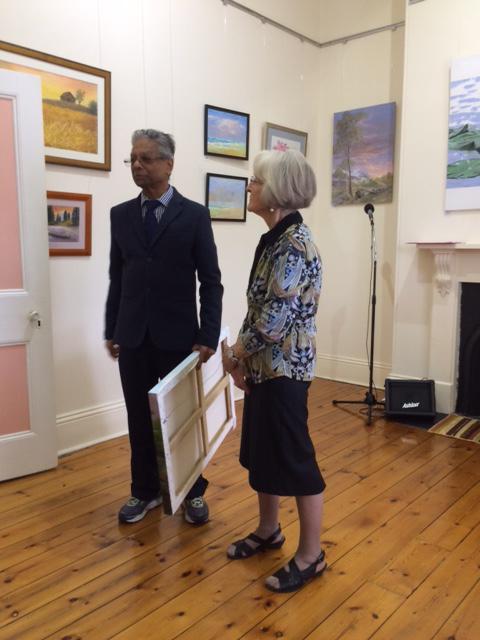
Tushar with Mrs Joanne Hughes
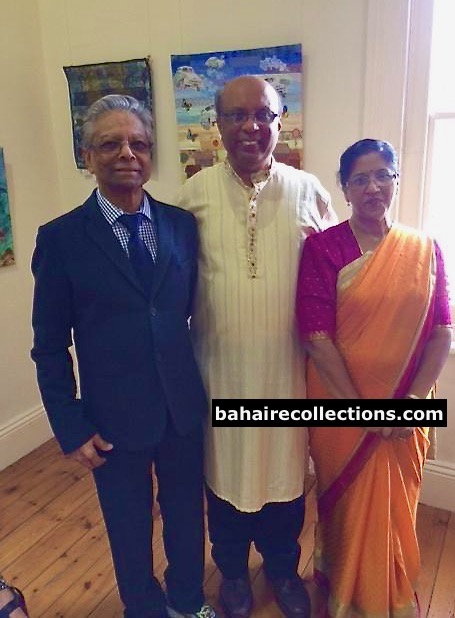
Tushar, Mayalagan and Kalaiselvi
This star servant of the Cause who had served the Cause with distinction in many ways passed away on 1 July 2020 in an aged care facility in Adelaide. Tushar was buried according to Bahá’í rites on 13th July, 2020 at the Willaston Cemetery situated in Dawkins Avenue at Willaston, South Australia. His indelible services for the Cause in the early days are well remembered in historical memory. Indeed, the Bahá’í community owes a debt of gratitude to the early heroes of the Cause and Tushar stands out as one of those outstanding worker. Many in the generations yet to be born would emulate the exemplary path Tushar had set as the first Bahá’í youth in Malaysia, and as the first home-front pioneer as well.
A. Manisegaran
31 July 2022
Copyright@bahairecollections.com
You may leave your comments at: info@bahairecollections.com
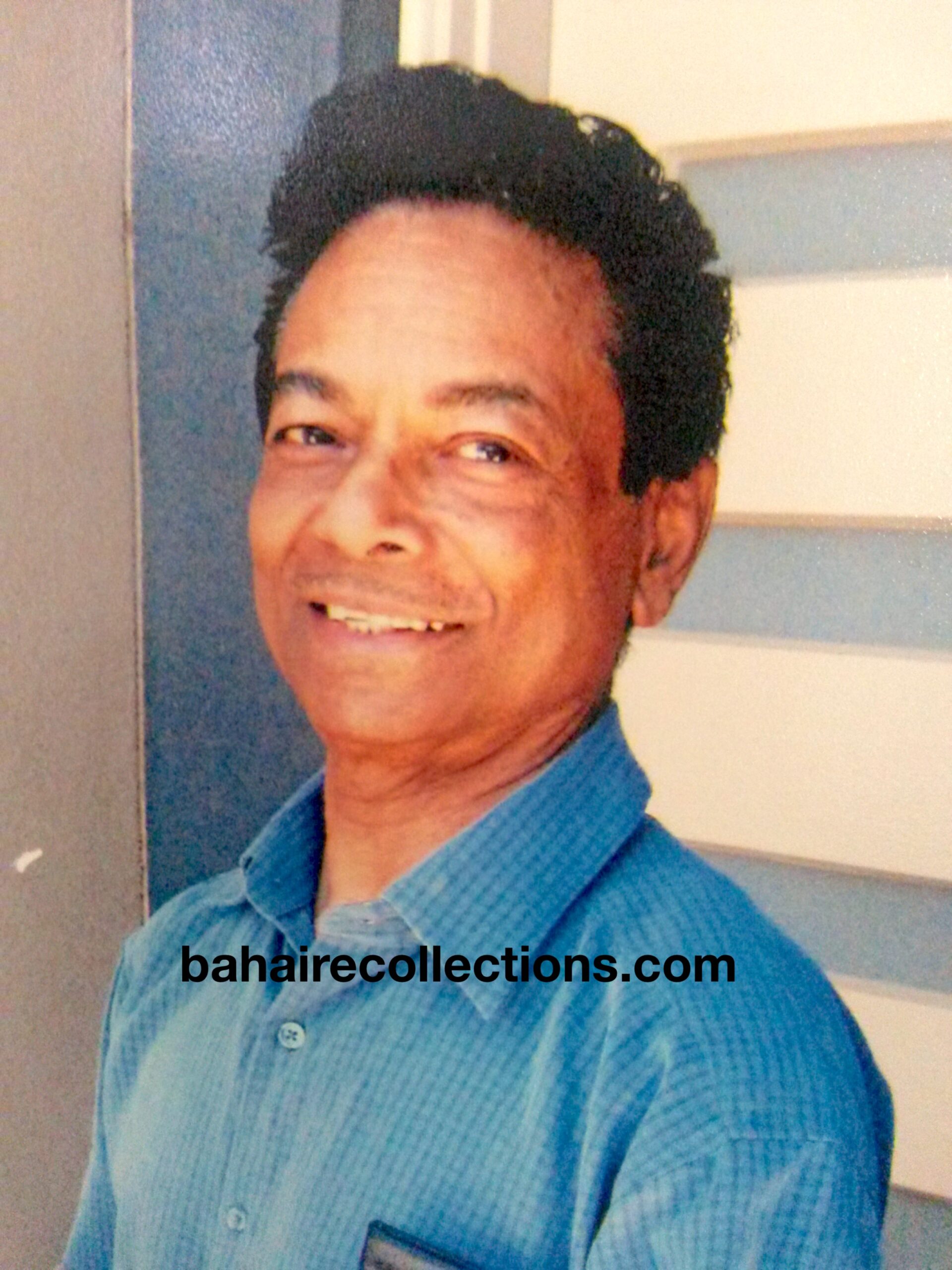
20 thoughts on “REMEMBERING TUSHAR KANTI-PAUL”
Thank you for sharing the story of Tushar Kanti-Paul, it has certainly brought back many fond memories of those early days in Malacca when we were just a handful of youth participating in teaching activities in a nascent Baha’i community which caught the accents and spirit of the Baha’i teachings, and worked for its propagation not only locally but nationally and quickly becoming international in a matter of years.
Tushar was definitely in the forefront in those early years as I remember him and his brothers Mrinal and Pijush attending activities held in our home, later becoming the Baha’i Centre. It was a hive of numerous firesides, Feasts and Holy Day celebrations and commemorations, home visits and a host of other community building activities that were filled with fun and purpose. It was a happy time, helping to foster many long lasting friendships to this day.
When Tushar settled in Adelaide South Australia I saw him on several occasions, and we were able to reminisce on those early days in Malacca, our hometown and the friends we knew.
I didn’t see him again after that and only spoke to him once on the phone and we exchange greetings briefly. By this time he was quite sick and didn’t fully remember many things about Malacca and the community he had once participated so actively in its growth and development.
I salute and pay my humble tribute to you Tushar, and pray for the progress of your spiritual journey, May God bless you forever.
“He is the Merciful, the Compassionate, Praise be to God, the Lord of all the worlds”
Leong Ho San
Wollongong
Australia
Thanks Mani for sharing the story of Mr Tushar Kanti Paul. He was my Art teacher in my school. He used to visit the Baha’i Community in Serkam Estate in the state of Malacca in the early 1960’s. He was an excellent teacher and a gentle person. Reading your story I was inspired to know his teaching activities in Australia. Truly a great teacher of the Faith.
Dr S. Nathesan
Muar
Johor
Malaysia
I have read about Tushar Kanti Paul , but not met him personally . Manisegaran has written so well his life story and his unwavering service for the Cause of God. Great job Mani, God Bless you and all always.
Professor Dr Ananthan Krishnan
Puchong
Selangor
Malaysia
Dear Mani,
Thank you for writing an account of Tushar Kanti-Paul.
I am deeply touched by the story of this gifted and pure-hearted Bengali teenager of Malacca.
It is a place of great beauty and befitting to the remains of an artistic man who did justice to his talent while serving the Baha’i Faith to which he dedicated his life.
Following the story of his life which ended in South Australia, I was moved to ‘google’ the Willason cemetery there.
Usha Cheryan
Melbourne
Australia
Dear Mani.
Thanks for sharing the story of Tushar Kanti-Paul.
Frankly I don’t know much about Tushar Kanti-Paul who is very much our senior, or the role he played in the early days of the Faith in this country. In this regard your write up has been quite illuminating. Thanks for your focused and useful service.
Cheers
Sathya Narayan
Subang Jaya
Malaysia
Thank you dear brother Manisegaran for taking us through the life journey of Tushar Kanti-Paul. This well research story is truly uplifting and inspiring.
“If only the friends could realize it, the glory of our Faith is not that people with unique abilities do the work of the Cause, but that it is done by the sacrifice of loving and devoted souls who arise selflessly to undertake work they feel themselves incompetent, sometimes, to achieve. God works through them and endows them with gifts they did not dream they could ever possess.” Shoghi Effendi, Quickeners of Mankind, p. 67
Above quote is truly reflective of the life of Tushar who had sacrificed selflessly.
Santhanasamy
Kuala Terengganu
Malaysia
Tushar Kanti-Paul and his brothers considered my mother Mrs. Shirin Fozdar as their spiritual mother and loved her dearly. So Tushar and I were brothers by proxy. He was a very active teacher of the Faith and a talented and respected artist.
I met Tushar several times on my visits to Malaysia when I lived in Brunei. He migrated to Australia in 1966 and worked as a teacher there and I migrated there several years later. Our paths crossed again when Tushar was a delegate to the National Convention, and I attended as Auxiliary Board Member from Western Australia
Minoo Fozdar
Perth
Western Australia
As soon as I received notification of a new story published- at midnight, I read it with the greatest interest and sleep left me as the story took me down the memory lane. Tushar as I called him accepted the Faith three years earlier to me iin 1954. When I came to work in Jasin in 1957, Tushar was already an active believer. He had done so much to establish the Faith in Jasin as a home front pioneer- the first home front pioneer. The later arrivals like Leong Ho Chiew and Raymond Peter and myself went around the town walking through every street and lane to teach the Faith to whoever came into our sight. Street teaching was so easy and so natural in those days. We were all together on the first Local Spiritual Assembly of Jasin that was elected in 1958. We both moved back to Malacca town, where Tushar was on the Local Spiritual Assembly of Malacca. He was very well organised and meticulous as Secretary.
When he bought a car, he used it for serving the Cause more than serving his own needs. Each weekend he would be driving to far off places to teach the Cause. And every now and then on the evenings of week days he would arrive in my house unannounced and ask me to jum in for a teaching trip to somewhere. I would take a quick shower and follow him to some English speaking areas. Whenever going to estate areas, he would bring along Tamil speaking believers like S. Vasudevan or when going to Chinese speaking areas he would bring along Chinese speaking believers.
It is unfortunate that he could not be in Malacca forever and had to migrate to Australia. I remember the day he was leaving. All of us were sad, and some wept. And when I read the part where Tushar had to spend his last days in a care center, I wept once more. Nobody knows what our future would be. It is best to serve while there is uncertainly of the future. And Tushar has served well in the prime of his days!
His stay in Malacca is well remembered. He set great examples in serving the Cause, as a youth and as a home front pioneer. We do not get such calibres these days as times have changed and the needs may be different. Yet Tushar is a book by himself. He and his services are examples forever for future generations to read and get inspired.
I am happy this unsung hero has been well recorded and with that he would be in history forever.
I thank my dear historian Manisegaran for presenting the story of Tushar enveloped in the spirit of those days that would never come by anymore.
Anthony C. Louis
Malacca town
Malaysia
Thanks Manisegaran for the story on Tushar Kanti-Paul and some mention on the other two Paul brothers- Mirinal and Pijush.
I had not met Tushar in person, and I do not know him, but now am grateful to your story on him. He was certainly a stalwart of the Faith in the early days. About Tushar, he being the first Baha’i youth was a big first step for the Faith. It is not easy to be a first generation Baha’i, especially when your original religion was Catholic. The whole church would go after you. Tushar read, learnt, and subsequently had even written some literature on the Faith in association with S. Bhaskaran, which Hand of the Cause of God Dr. Muhajir appreciated. He remained steadfast, certainly a stalwart for the youths today to follow.
The elder brother Pijuish migrated to Canada and I had a chance encounter with him in the late 1990s. He had already been in Toronto for some 20 to 30 years. He held a number of exhibitions of his paintings. In the early years his finger painting technique did make an impact and was reported in the newspapers in Canada. He opened an art shop in a mall but by the time I met him in late 1990s his art business wasn’t doing well and he had to close shop. He gave some of his paintings on Malaysian scenarios to the Baha’i centre and in recent years they were given to the staff at the Baha’i Centre. I have with me one of his paintings. I have lost contact of him. But i know despite his difficulties he remained faithful to the Faith.
Lum Weng Chew
Toronto
Canada
It is very fascinating to read the story of Tushar Kanti-Paul who, as a youth had embraced the Cause of God and devoted his life totally to the service of the Cause. Not only did he become the first youth to accept Baha’u’llah in Malaysia as the Manifestation of God but by doing so he started introducing a new mindset of thinking about life to many souls he came across.
I am very closely associated with the early believers of Malaysia, and the name of Tushar Kanti-Paul was not widely mentioned. There had been one or two writep ups on him, yes. But never did I know that this youth had done so much for the Faith in so few of his hears in Malaysia. He is one of the unsung heroes whose name and fame have now been recorded for posterity. And that may also explain why I am an ardent lover and reader of the Bahai Recollections Historical Blog.
From what I have read, Tushar had seized many opportunities to promote the Faith in the course of his services, and had joined other early believers to establish a firm foundation for the development of the Faith in Malaysia in the early days. As the first home front pioneer too he had led an exemplary mode of behavior for thousands of youth in those days and something that shall be appreciated for ages to come.
It is not an overstatement to iconize Tushar Kanti as one of the distinguished stars of the Faith in Malaysia. Indeed, Tushar, like his contemporary veterans of the Faith has decorated the pages of history in Malaysia with golden letters. We are sure to witness the eternal fruits of such endeavors rendered in the path of service to manifest their impacts in the process of the creation of the Promised Divine civilization and the Kingdom of God on earth. Now we have the Nine-Year Plan opened before us. The question is how we are going to plan and engage in its execution for the betterment of the world. Let us all execute the plan of God in the same spirit that was there during the early days of the Faith. Tushar who tirelessly devoted his life to the Faith has set such an example.
I hope the current generation of Bahai youths would read this and such other stories to get fully charged, energized and enthused to rise to higher level of service
Dr. Firaydun Mithaq
Chieng Mai
Thailand
I remember Tushar in my prayers and ask his all-conquering soul to assist us serve on his behalf in this historic Nine Year Plan.
Bijan Bayzaee
Northbrook, IL
U.S.A.
Thank you for writing about Tushar, the first youth to accept the Faith in Malaysia. He actively served on the field and was recreated by the spirit of Baha’u’llah.
“As you have faith so shall your powers and blessings be.” He served the Faith with full faith and conviction.
We are really proud of Tushar.
Ranee Sreedharan
Kuala Lumpur
A remarkable soul, dedicated and served his Lord to the best of his ability. I spoke with him while in his nursing home in Australia but never met him.
Silan Nadarajah
Sydney
Australia
Thank you for sharing this story! I is very beautiful and impressive to learn how Tushar Kanti Paul dedicated his life to his faith since he knew about it. Wherever he was he was taking together all of it materially and spiritually? I love his story.
Regards
Kalo Fakatou
Redwood City,
California
USA
Dear Manisegaran
I have not met Tushar Kanti Paul but after reading your story, I seem to have missed him terribly. Indeed a great soul who walked in our midst during our own lifetime.
Tushar has certainly done so much for the Cause as an exemplary youth. He was there when the Faith needed him- providing the manpower at a time when early foundation was laid for the Cause in Malaysia.
His story was really very moving. He has set example in every way in Malacca. Having moved into Australia too he had done so much for the Cause. Tushar has understood the mission of Bahaullah very well. Once a Bahai, always a Bahai is what he had etched within his soul. He died with his boots on as a believer and was given Bahai burial. Today he is well remembered in history. May his soul progress in all the worlds of God.
Ganavathy Naidu
Kuala Kerai
Kelantan
Malaysia
I remember Tushar Kanti Paul very well. He was one of the most active youth in the Malacca Baha’i community when I first visited Malacca.
We became close friends, and that’s why I invited him to conduct our marriage even though he was younger than me.
I will always remember him as a true servant of Bahaullah.
Maheshwar Dayal
Canada
This is a brilliant recollection — of the youngest soul who embraced the Cause of God, sincerely served the Blessed Beauty at any given opportunity and remained so steadfast in the covenant till his last breath. Wow! what a life, lived! I have learnt about him in other books by the author – ‘Jewel Among Nations’ and the ‘Dawnings and An Account of the Early Days of the Bahá’í Faith in the State of Malacca’. However, this in-depth recollection has brought to light the spiritual energy and vital part so elegantly played by Mr. Tushar Kanti-Paul for every youth of the world to emulate. My appreciation and respect go to the author for his great work on Mr. Tushar Kanti-Paul.
“… From the very beginning of the Bahá’í Era, youth have played a vital part in the promulgation of God’s Revelation. The Báb Himself was but twenty-five years old when He declared His Mission, while many of the Letters of the Living were even younger. The Master, as a very young man, was called upon to shoulder heavy responsibilities in the service of His Father in ‘Iráq and Turkey, and His brother, the Purest Branch, yielded up his life to God in the Most Great Prison at the age of twenty-two that the servants of God might ‘be quickened, and all that dwell on earth be united’. Shoghi Effendi was a student at Oxford when called to the throne of his guardianship, and many of the Knights of Bahá’u’lláh, who won imperishable fame during the Ten Year Crusade, were young people. Let it, therefore, never be imagined that youth must await their years of maturity before they can render invaluable services to the Cause of God.”
(From a letter of the Universal House of Justice to Bahá’í youth in every land, June 10, 1966)
May his soul find eternal comfort and happiness in the all the realms of God. Ya Bahá’u’l-Abhá.
With loving Bahá’í greetings,
Vela Gopal
Phnom Penh, Cambodia
Dear Mr. Mani,
Thank you again for bringing to light the story of a great stalwart whom most of us in our generation may not know. What a moving, inspiring and unprecedented soul he was from his youthful days till his last breadth. He was truly a light and glory of the Malacca community and also to the youths of today. His passion was teaching and to serve the exalted threshold of Bahaullah.
The name Tushar Kanti is famous in the North East Indian States like Bengal, Odisha, Assam and Tripura. When I landed as a pioneer in Odisha 1977 the first Bahai that I met was a youth by the name of Tushar Kanti Das who received me in the Bahai Centre in Bhuavaneswar.
It is really quite fascinating and interesting for me to know and learn about Mr. Tushar Kanti Paul from your detailed, informative and untiring research made on this valiant soul of the Cause of God.
And also it is heartwarming to note that he had played a special role in the erection of the first National Teaching Institute building of Malaysia.
He was the first youth to accept the Faith in Malaysia and the first homefront pioneer and also has served as a Secretary of the Local Spiritual Assembly of Malacca town, and later as an Auxiliary Board member in Australia. A person who has served the Cause with much determination and distinction. He obviously can be said as a legendary Bahai figure for us.
For all the services he had lovingly and laboriously carried out, he must be now in a special place in the Realms of God. May his pure soul progress in all the worlds of God.
Thank you
Pitamboro
Kuala Selangor
Malaysia
Dear Mani
Thank you for writing about Tushar Kanti-Paul. By the time I accepted the Faith in Malaysia Tushar had already migrated to Australia. After accepting the Faith, I heard many nice things about him from some of the Bahais. When I went to stay with Raymond Peter in Jasin in 1968, he mentioned very nice things about Tushar, especially on how well versed he was in the Writings, and how active and committed he was in undertaking activities for the Cause. When I met Inbum Chinniah who was Secretary of the National Spiritual Assembly, at his home in Jasin, he too said that Tushar migrating to Australia was a great loss to the Malaysia Bahai community as he was such a great youth with great dynamism to serve. Somu of Malacca town too said great things about Tushar.
Having heard so nice things about Tushar, I felt I had missed someone so special and had never got to meet him at all. After reading your detailed write up about him I can see why the early believers had do say so many great things about him. Your write up clearly shows that Tushar was indeed a great youth who had done great things for the Cause of God.
He had indeed set a fine example for the youths of these days to emulate. It appears that he had been chosen to serve the cause when the Faith and the community in Malacca were just coming up. I sincerely hope the believers of the current generation would read such stories that carry so much information and inspiration not to be found elsewhere.
C. Kanagaratnam
Arizona
USA
Thank you Mr Manisegaran for bring out another episode of early Malaysian Baha’i history.
I am really impressed how as a young man Mr Tusar Kanti Paul discovered the Faith and immediately started serving as home-front pioneer. He surely has been touched by the message of Bahaullah, He has set good example for the present generation Bahais. He is an inspiration and we are grateful for his services. I believe he would have done more for the Faith had he remained in this country. Nevertheless he had done equally well in Australia as a Board member and a talented artist.
This story is another precious piece of history of the Faith in Malaysia.
Thank you Mr Manisegaran for writing this and looking forward to another masterpiece from your penmanship,
Nehru Arunasalam
Chicago
USA